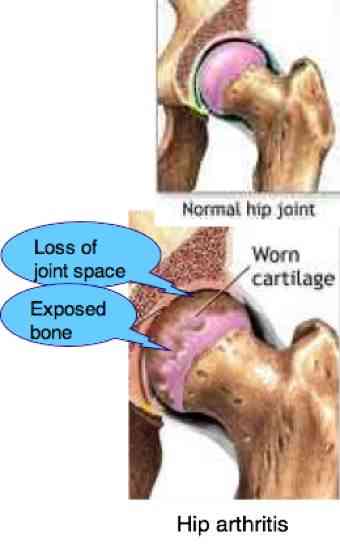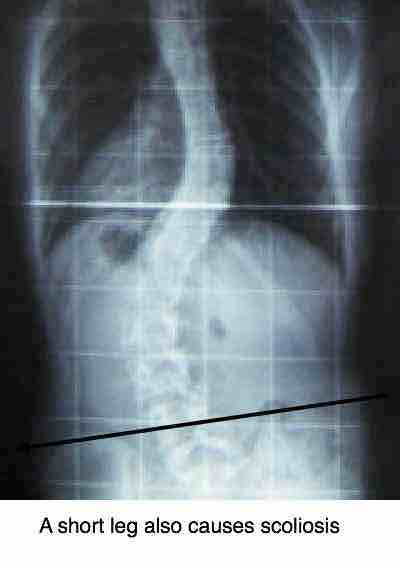Leg length inequality
Leg length inequality leads to more arthritis in the hip, knee and back.
The relationship of limb length inequality with radiographic knee and hip osteoarthritis was researched by Golightly et al, and reported in the journal Osteoarthritis and Cartilage. They conclude that there is strong correlation in the knee, but to a lesser extent in the hip, where the hip on the short leg side was more likely to be arthritic.
Interestingly, folk with a short leg were also more likely to be obese, with an average BMI of 29.0. It would seem they are less likely to be active.
Hip arthritis

The causes of knee and hip arthritis are legion, but leg length inequality must be included.
Health is additive, both in a positive and a negative sense. If you are a couch potato and smoke, you're even more likely to get a host of diseases.
Likewise, if you are overweight, and have a short leg, then arthritis of the knee and hip are highly likely.
Conversely, if you are active and walk or swim regularly, for example, and use an orthotic to correct for a short leg, then you are far less likely to have these arthritic disabilities; eat plenty of omega 3 rich foods and you're home and dry.
It is well known that osteoarthritis is one of the most common, chronic conditions and a leading cause of disability among older adults. This is particularly true in the USA where obesity compounds other known causes, arthritis of the knee affecting six percent of the adult population and of the hip, three percent.
This study examined the relationship of limb length inequality (LLI) with radiographic hip and knee osteoarthritis (OA) in a large, community-based sample.
Hypothesised is that a short leg alters gait symmetry and joint mechanics during weight bearing, potentially contributing to the development of arthritis in the knee and hip.
Results
They found that those with LLI were 80% more likely than those without a short leg to have radiographic knee OA, and but only 20% more likely to have hip arthritis seen on x-ray.
In the presence of a short leg, hip OA was found to be 30 percent more common on the short leg side versus 18% on the longer limb.
Here is the hypothesis.
They speculated, with support from other studies, that mechanical factors, including joint instability and malalignment, contribute to the progressive degeneration that characterizes radiographic OA. Said the authors;
Individuals with short leg often modify their movement patterns to functionally minimize the inequality, i.e., increasing knee flexion or hip adduction of the longer limb. These compensatory mechanisms may amplify forces across a smaller joint contact area, thus acting as a biomechanical precursor to lower extremity OA.
“A short leg may lead to altered or amplified joint forces, resulting in accelerated degeneration of joint structures and increased OA severity.”
The authors's definition of short leg was a difference of more than 2cm, as they felt that a lesser inequality would not be "clinically meaningful", an opinion that chiropractors, with the spine rather than the hip and knee in mind, would take issue with.
“These results may have important clinical implications for patients seeking treatment for knee or hip OA. Evaluation of LLI should be incorporated into physical examinations for these patients.”
Conclusion
“Treatment of the anatomically short leg in patients with knee or hip OA, with heel or shoe lifts, may aid in reducing joint stresses, pain, and disability, but more research needs to be done.”
Leg length inequality
Leg length inequality research on 926 subjects recommended that LLI was an important consideration in the physical exam.
Leg length inequality is one of the most common causes of scoliosis and degenerative change in the lumbar spine too.
How common is LLI in persons suffering from LBP?
In a remarkable study done on servicemen suffering from LBP, researchers discovered that ...
LEG LENGTH INEQUALITY RESEARCH ...For the Chiropractor
- With the Chiropractic emphasis on prevention rather
than simply the treatment of disease, perhaps more emphasis should be
given to the use of heel and shoe lifts, not simply for the patient WITH
osteoarthritis, but for the pre-arthritic patient.
- Have any Chiropractors done research on a
presumed association between osteoarthritis of the spine and LLI? Could
mechanical factors, including joint instability and malalignment, also
contribute to the progressive degeneration that characterizes
radiographic OA of the lumbar, thoracic and cervical spine?
- Most significant is the opinion of the authors
that: "Evaluation of Leg Length Inequality should be incorporated into
physical examinations for these patients." Why not every pre-arthritic patient?
- Should the authors be correct in their thesis that "mechanical factors, including joint instability and malalignment, contribute to the progressive degeneration that characterizes radiographic OA" in the knee and hip, could we not assume that the same holds true for the spine?
From LLI to Research @ Chiropractic.org

Case file
How does this work out in practice? The first thing a chiropractor would do would be to check out the feet when examining a new case file. A dropped medial arch with concommitent pronation would obviously contribute to a short leg syndrome. A suitable arch support such as provided by FOOT LEVELERS, without a heel raise may be adequate to level the pelvis.
Short leg
Short leg is of course just another name for leg length inequality; would a rose smell any different if you gave it another name? Does lumbago hurt more than low back pain? A leg length inequality is often a consequence of conditions such developmental hip dysplasia.
Sacroiliac Joint Treatment
Due to altered biomechanics leg length inequality also contributes to osteo-arthritis in the sacro-iliac joint. For more about the chiropractic Sacroiliac Joint treatment click here:
Neck pain
A Journal of Rheumatology report confirms the connection between LEG LENGTH INEQUALITY AND LOW BACK PAIN, and invites questions about the use of heel lifts in the treatment of recalcitrant neck pain.
Read more: LEG LENGTH INEQUALITY AND LOW BACK PAIN
Knee Joint Distraction
Research confirms that unloading of joints and increasing cartilage perfusion can dramatically reverse osteoarthritic changes.
Read more: KNEE JOINT DISTRACTION
Contribute to Research topics you would like to see evauated: COLLEGE RESEARCH TOPICS ...
Pain in upper leg
There is nothing simple about leg length inequality,
particular when it's associated with other conditions. It frequently
causes a sacroiliac syndrome, perhaps a Maigne's, often in the older
person there is associated Immobilisation Arthritis from a life time of
subluxations.
Perhaps there might be hip arthritis, more common with a short leg; it takes a chiropractor as pertinacious as Robert the Bruce's spider to sort all the threads out[1].
(PS. Do you know the story about how Robert the Bruce was inspired by a spider? It's a fascinating yarn.)
When browsing these links use right click and "Open Link in New Tab", or you may get a bad gateway signal.
Did you find this page useful? Then perhaps forward it to a suffering friend. Better still, Tweet or Face Book it.
